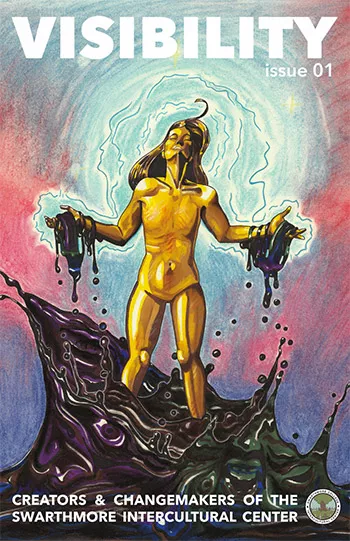New Student Publication Raises Visibility of Underrepresented Voices

A new campus publication hopes to bring visibility to those who often feel invisible.
VISIBILITY Magazine, an e-zine published by the Intercultural Center (IC), is an outlet for Swarthmore students, especially those of marginalized identities, to be recognized not only for the challenges they face, but also for the powerful artwork, stories, and experiences they have to share with the wider community.
The first issue officially releases tonight at the Annual Intercultural Center Awards Banquet. A few limited print copies will be available on campus and the issue can be viewed online.
The project is the brainchild of Jasmine Rashid '18, a peace and conflict studies special major from Oyster Bay, N.Y. Rashid had been interested in e-zines for some time, and when she applied to work at the IC, she saw it as an opportunity to bring one to campus.
"I was really fascinated by the agency that these kinds of platforms can provide creators," she explains. "Often, there are no editors, no sponsors, and no advertisements. Groups of friends or colleagues can put together publications, often for free, that can easily be distributed online."
Mo Lotif, Assistant Director of the Intercultural Center, saw the project as a perfect fit. "The Intercultural Center has been a space for raising consciousness around the plurality of voices, worldviews, and embodiments that comprise the Swarthmore community," he says. "The zine is a beautiful, heart-rendering way of continuing this legacy of consciousness-raising.”
The first issue features 20 student submissions and over 50 pages of content. After the submissions were received, Christine Lee '18, a political science and Asian studies major from Seoul, South Korea, designed the issue, finding a way to place all of the pieces in an aesthetically pleasing layout.
In addition to featuring students from the IC, the extended list of contributors to the zine includes students from the Black Cultural Center, the Women's Resource Center, the Interfaith Center, and the International Students Office. "The nature of this work is extremely collaborative," says Rashid. "It's amazing to see where parallels can be drawn amongst a multiplicity of experiences."
Lotif agrees: “I hope community members, alumni, and prospective students alike will find themselves reflected in the zine, even if it’s in just one story, sentiment, or image. This project can signal to readers that our individual experiences do not exist in isolation. If we look, with openness and compassion, we can see just how interconnected our struggles and our triumphs are.”
Vivek Ramanan '18, an IC intern working as outreach coordinator for VISIBILITY, is excited by how the zine has come together. "There was so much variety in the work submitted, including different genres of art and unique perspectives."
Ramanan, a biology and computer science double major from San Jose, Calif., also submitted work to the zine, which he described as a nitty gritty process for him, but one that was ultimately rewarding. "By not only working on my article but also seeing the other incredible art in the zine, I saw the range of issues and stories that Swatties are passionate about and willing to share their thoughts on."
For Rashid, working on the zine coincided with her time in Professor of Dance Sharon Friedler's Art as Social Change course, which helped her realize that while many people do not consider themselves artists in the traditional sense, everyone has the power to create and express their experiences.
"The class is really about exploring the ways in which those who are historically silenced can be given outlets, as well as the fact that once art is put into the world, it has the ability to influence perspectives and alleviate pain, " she says.
This lesson is something VISIBILITY Magazine takes to heart as it provides a space for silenced voices and builds community through sharing these perspectives.



